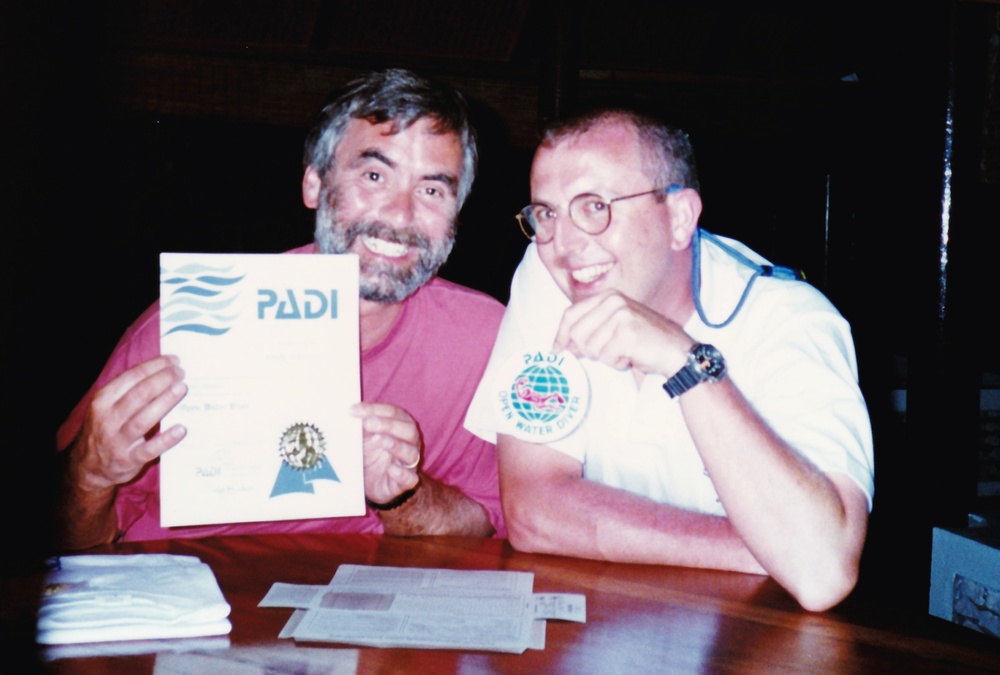This site looks much better with JavaScript turned on. For the best experience, please enable JavaScript and refresh the page.
Our first holiday in the Maldives. We'd seen a pretty good deal from Kuoni for a fortnight at this all-inclusive resort, so decided to go for it. Having read all the books and brochures raving about the fantastic underwater life in the Maldives, John decided that this was the opportunity to learn to dive.
A long and uncomfortable flight with a stop-over in Bahrein, then we dropped into paradise. As we approached Hulule Airport, we could see the coral islands and reefs below dotted all over the sea which shone in a million shades of blue.
Hulule airport occupies an island next to Male, the capital island. Hulule has been extended in a north-south direction to take big jets. The usual delays through customs, where our baggage was searched for alcohol (duty-free imports not allowed), then out into the heat of the arrivals area, where after a cooling lemonade at a bar, we were soon driven by minibus back across the runway to the seaplane terminal (at the right of this picture).
Hulule International airport.
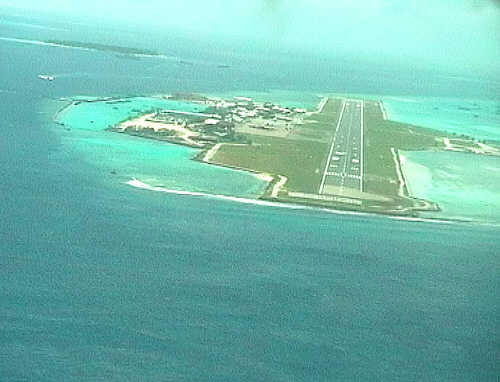
What an experience this was - taking off on a seaplane for a forty-minute flight low over the ocean to Thudufushi Island in South Ari Atoll. More spectacular views of coral islands and reefs, then an exciting landing on the lagoon beside the island, taxying over to a pontoon, where we changed over to a dhoni for a short ride to the island's jetty.
The edge of Ari Atoll.
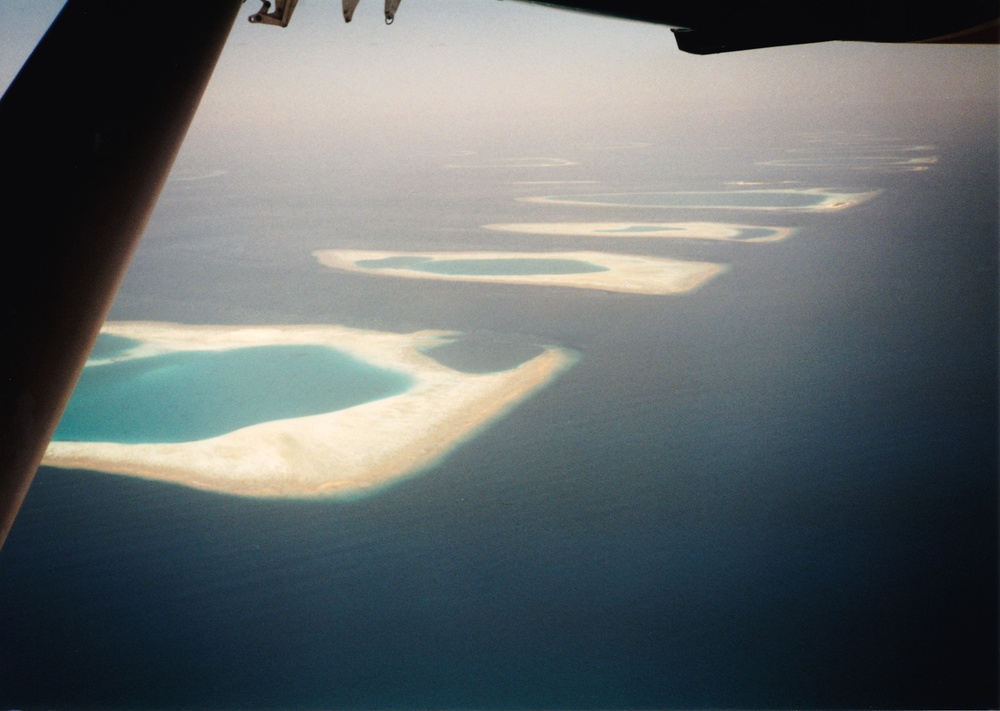
We were soon settled into our fantastic room - huge, with aircon and a ceiling fan, fridge, sofa, coffee table, outside shower room, and a covered veranda on the beach with sun-loungers and a bowl of water, freshly changed each day, to wash the sand off your feet.
Our veranda.
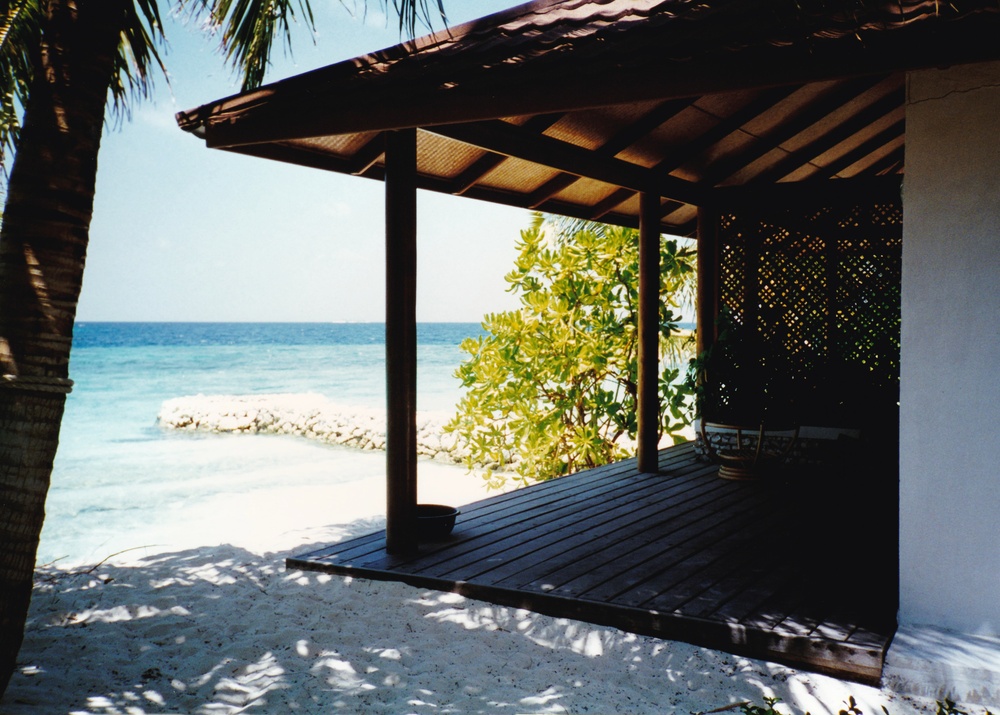
Then we went exploring. We walked right round the island on the beach in twenty minutes - it's only a few hundred yards across. The hotel occupies the entire island, with the guest rooms around the outside on the beach, and the staff quarters, generator, laundry etc in the middle. The island was very well run by an Italian company. There was a souvenir shop and a medical centre with a resident Italian doctor (who spoke little English).
Walking around the island.

Local workmen setting off to rebuild some of the coral walls protecting the beaches.

At the right of the picture is the restaurant, with open sides, and a view across the beach to the sea. The food was excellent, well-cooked. We were quite happy with coconut fish curry and rice, but there was plenty of other choice as well. Our all-inclusive deal included as much good-quality, bottled, wine as we wanted, even Italian bubbly. Excellent. The main cocktail bar (in the middle) was next to the restaurant. At the left is an area used for discos, crab races etc.
Main restaurant buildings.

We got into the habit of ordering a bottle last thing at night and taking it back to our room to finish off relaxing on the veranda in the warm night breeze, while watching the moonlight on the water.
This is John getting as relaxed as a newt.
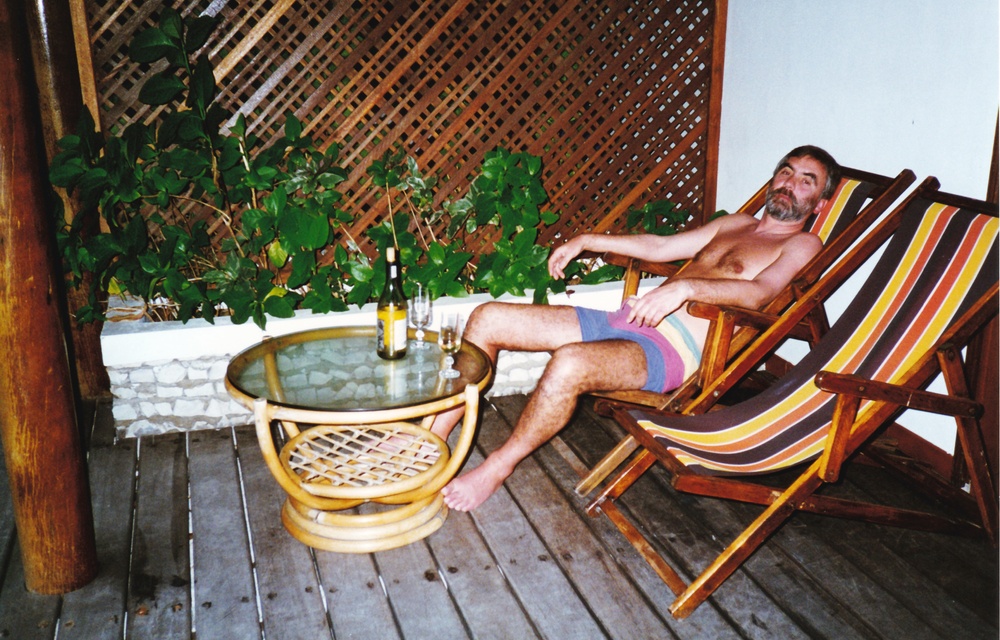
The beach bar near the watersports centre was run during the day by a couple of really friendly Sri Lankan guys who spent most of the holiday with a transistor radio on the counter, listening live to the 1996 Cricket World Cup. They became more and more excited as Sri Lanka progressed through the tournament, and were over the moon when they beat England in the final.
There was a wide area of soft white sand near the beach bar, with sun-loungers.

From Reception, the wooden jetty ran out across this sandy area, and over the coral reef, floodlit at night, to the edge of the drop-off, where the boats were moored. You had to wear sandals on this jetty during the day to avoid getting your feet burned. A family of three frying-pan-sized sting-rays used to shelter under the jetty during the day - they were quite friendly, allowing you to stand in the shallows right next to them.
Area of sand near the jetty.

The only wild-life we saw on the island were a couple of herons on the beach by the jetty, some crow-like birds who skulked around in the trees, and some geckos on the walls at night. The herons liked to visit our veranda to sip at the bowl of water set out for us to wash the sand off our feet. There were also loads of crabs. We found this tiny hermit crab walking across our veranda one night.
Tiny hermit crab.
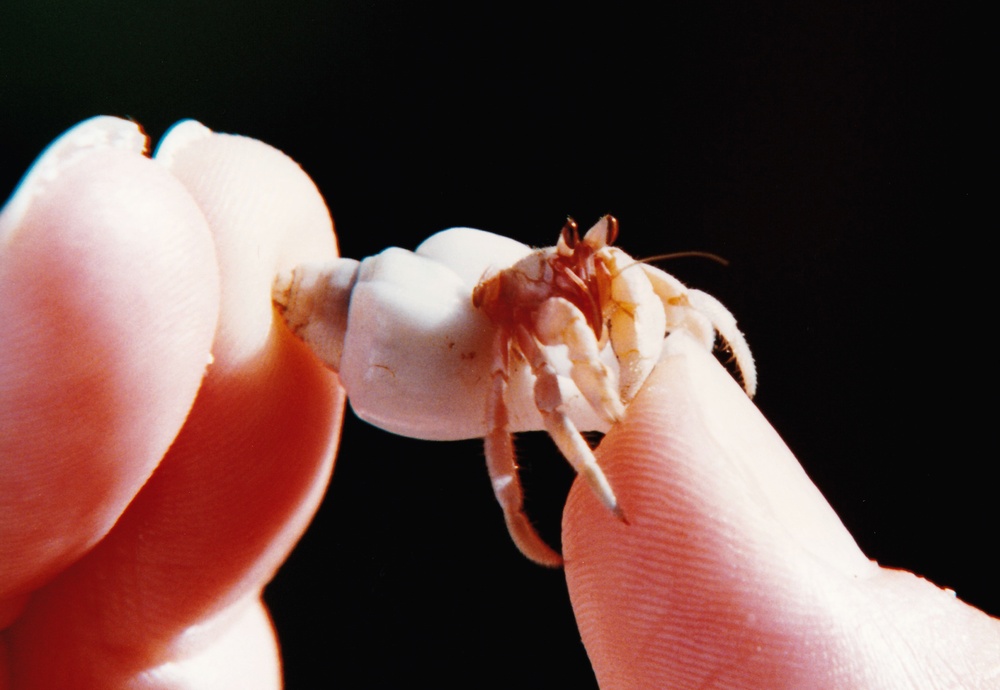
Linda perched on a palm tree just outside our room at high tide.
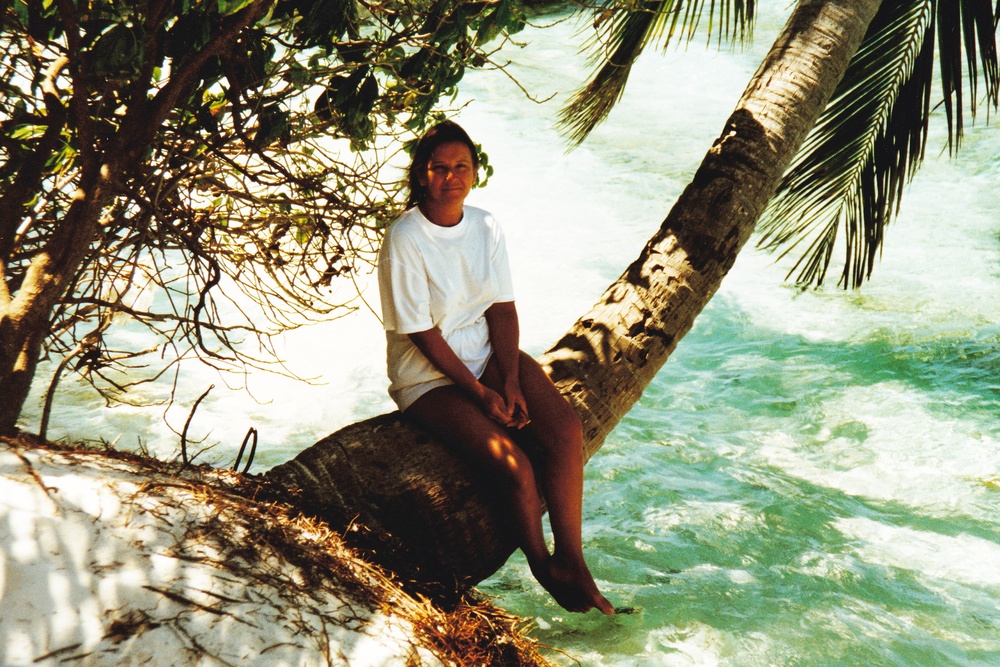
Snorkelling:
We hired snorkelling gear from the watersports centre and went snorkelling. Practically the first thing we saw on a coral outcrop near the jetty was a tightly-packed shoal of about 40 brightly-coloured parrot fish feeding on the coral. We could clearly hear their beaks rasping away at the hard coral.
Everywhere we looked there were beautiful technicolour fish - a great introduction to the underwater life of the Maldives. Linda hadn't done any snorkelling before, and was really impressed.
We took this picture of a Striped surgeonfish (Acanthurus lineatus) with a waterproof disposable camera.

You could fin through gaps cut in the fringing reef out to the drop-off, where the coral drops steeply away from a couple of meters depth down to about 30m. The drop-off is where the best fish and coral are. You can swim along the edge of the drop off round the island, coming back in through another gap. You got to recognise the gaps by the coral formations on either side of them. The one nearest our room had an enormous brain coral about three metres across next to it, so was instantly recognisable. The reef teemed with fish of all sizes, shapes and colours swimming in amongst the brilliantly-coloured corals.
John's Diving Report:
I signed up for the PADI Open Water Diver course at the "Crab" Dive Centre. My first experience of the joys of diving came when I and some others were filling in the forms. One of the others was squinting at the small print on the forms, wondering aloud "What does all this mean?". I replied, "It means, whatever happens, it's not their fault." "No, no!" replied the Italian dive leader behind the counter, "it means, whatever happens, it's your fault!"
There were three dive instructors - one Italian, one German and one Brit. I was assigned to the Brit. I later discovered that I was his first trainee - he had only just passed his instructing exams, and in fact had arrived in the Maldives on the same plane that we had. Graeme Dean turned out to be a great guy, thoroughly professional - I wouldn't have guessed that he hadn't taught for real before. He was a professional diver, working mainly on North Sea oil rigs, and figured that a year or two teaching in the Maldives would be less stressful.
Graeme explained that there was a bit of classroom theory to do during the course, and offered me the choice of doing it in the middle of the day or in the evening. Since I knew that during the first few days of the holiday, I'd need to stay out of the midday sun, and I wanted my evenings to be spent in the bar getting our money's worth from the all-inclusive deal, I chose the former. The theory was pretty straightforward, and I sailed through this, to Graeme's obvious relief.
The classroom sessions were interspersed with regular trips to the beach to practise in the shallows what we'd learned in the classroom. This was fantastic - practising the drills kneeling down in chest-deep warm clear water, so if you got confused, you just stood up. And small fish continually swam around your feet, whetting your appetite for more. I learned how to use the regulator, how to buddy breathe, how to clear my mask - all the basic stuff.
I'm on the right of this group, with Graeme in the garish wetsuit with his back to the camera.
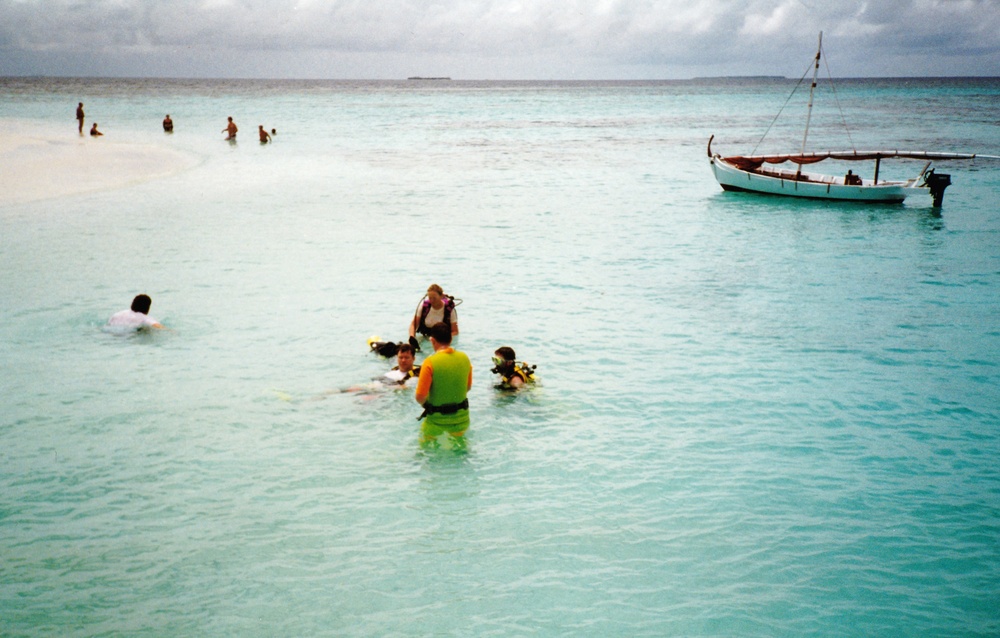
After a few such dives we moved out to a penned-off area next to the end of the jetty, where the water was about 5m deep. Here we repeated all the exercises while trying to ignore the swarms of vivid yellow blue-striped snappers, oriental sweetlips and other fish sheltering under the jetty, and the colourful coral and reef fishes next to it. We also learned how to take off and put on all the gear while underwater or on the surface.
Beautiful fish under the jetty next to our practice area.
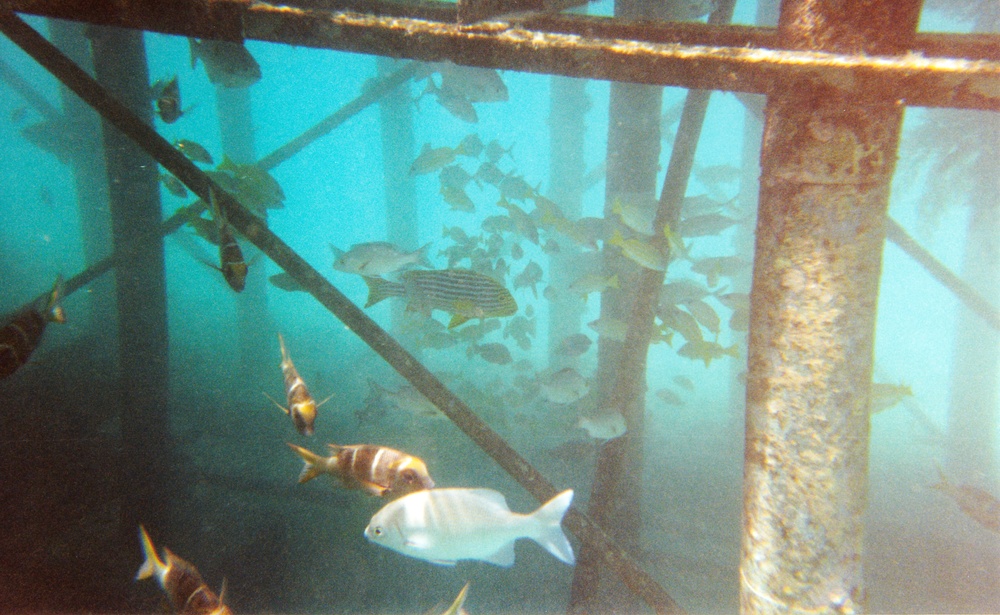
Soon it was time for our first open water dive, and off we went on the dhoni to Panettone, Manta Point.
Off on the dhoni.
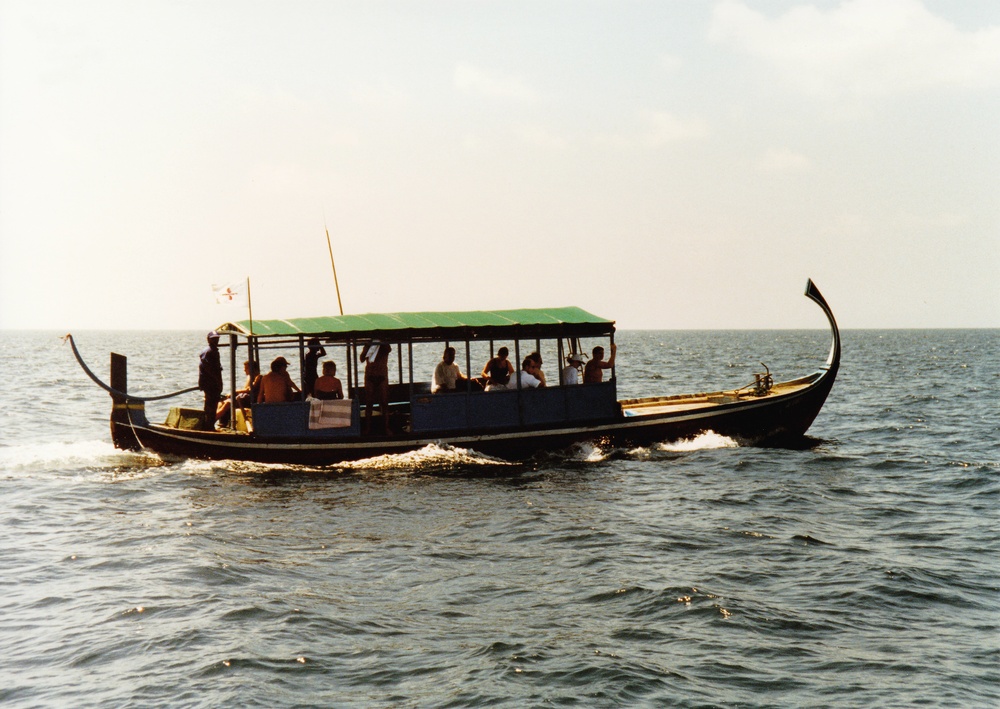
The Giant Stride off the side of the boat took a bit of getting used to, but safely in the water, we completed the pre-dive checks and then Graeme gave the signal to dive. I went down to 5m and waited as instructed, while watching pairs of legs thrashing above me. One of the other two trainees was having problems each time her head went under water, and her husband became increasingly sea-sick waiting on the surface for her to dive. Eventually, after about ten minutes while I patiently kept station at 5m under the trio, as instructed, Graeme ducked his head under the water, pointed at me and made an emphatic "surface now" signal. I wasn't surprised. I cast a regretful look at the coral reef below me and surfaced. Graeme apologised but the dive would have to be aborted - the other two were either puking up or out of air.
The next day, I discovered that the other two had decided to take it slower, and have a break for a few days. This suited me down to the ground, as I now had Graeme all to myself. Back to Manta Point, and a great dive, during which I practised again all the things we'd done in the shallows, this time at 12-15m in open water. I couldn't believe that I was able to take off my mask, put it back on again, and clear it, just like the book said - it all seemed so easy. Graeme said that I was very confident in the water, and that made all the difference - being calm and in control rather than always on the verge of panic. And then Manta Point lived up to its name - I saw three big Manta Rays during my safety stop.
More dives followed - during my third open water dive I again glimpsed a manta ray. But my fourth open water dive was a cracker - we hadn't been in the water very long when three huge mantas glided effortlessly past us on the edge of visibility. They banked elegantly and swam back towards us. The next ten minutes were out of this world as the mantas whirled and banked close all around us while we sank to the sea bed in awe. On the same dive I saw a grey reef shark, a Napolean Wrasse and a big turtle. What a way to start my diving hobby - and I haven't seen any mantas since! *(Oh yes I have.....)
One more dive and I was the proud possessor of a PADI OWD certificate. As I celebrated in the bar with Graeme that night, I had a huge grin on my face - you can teach an old dog new tricks after all.
Celebrating with Graeme.
